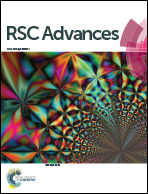Investigations into a thiol-impregnated CaCO3-based adsorbent for mercury removal: a full factorial design approach
Abstract
Airborne mercury, mostly from coal-based power plants, deposits in rivers, lakes, and oceans, and moves up the food chain resulting in adverse effects on humans and ecology. This study focused on an innovative idea of impregnating calcium carbonate with a thiol compound, 2-mercaptobenzimidazole (2-MBI) for mercury adsorption. The impregnated adsorbent was characterized for surface morphology and surface chemistry by using FTIR, FESEM and EDX analyzers. A constant concentration of 15 ppbv of Hg0 was generated through a permeation tube and passed through the adsorbent bed. A 32 full factorial design of experiments with three replicates, a total of 27 runs, was employed for adsorption studies. Two factors, (i) temperature (80, 110 and 140 °C) and (ii) mass of 2-MBI (5, 10 and 15 wt%), were investigated for Hg0 removal. A regression model was developed and validated by applying ANOVA analysis to study the effect of temperature, mass of 2-MBI and their interaction on Hg0 adsorption. The results showed that Hg0 adsorption increased with increasing temperature and mass of 2-MBI. The maximum Hg0 adsorption (7.54 μg g−1, 78% removal) was obtained at 140 °C and 15 wt% of 2-MBI. This study indicates the 2-MBI impregnated CaCO3 has potential for Hg0 removal and opens an avenue for concurrent removal of SO2.


 Please wait while we load your content...
Please wait while we load your content...